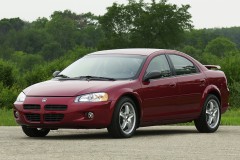Dodge Stratus 2001 2.4 petrol description
Sedan Dodge Stratus 2001 2.4 has been produced from 2001 to 2006. It has four-cylinder petrol engine with displacement of 2.4 litres, which produces power of 152 horsepower on 5200 rpm and torque 226 Nm (Newton metres) on 4000 revolutions per minute.
This 4-cylinder 16-valve engine camshaft is driven by belt (What is an engine chain and belt? ). Engine has fuel injection system, it has no turbine. Engine versions compliant with Euro 3 and Euro 4 emission standards available.
More engine specs
This engine features a thin-walled cast-iron cylinder block, an aluminum cylinder head with dual overhead camshafts, a timing belt system, two balance shafts, hydraulic lifters, a dual-mass flywheel, and a ...
This Dodge Stratus 2.4 engine oil type is 5W-30, 5W-40 and oil capacity is 5.5 litres.
Dodge Stratus 2001 2.4 has front wheel drive (FWD) and manual gearbox with 5 gears.
The maximum speed of this car is 180 km/h.

Dodge Stratus 2001 2.4 technical data
| Model: | Dodge Stratus 2.4 | ||
|---|---|---|---|
| Body style: | Sedan | ||
| Production period: | 2001. January ... 2006. January | ||
| Engine: | 2429 cm3 Petrol, 4 cylinders | CO2 emissions: | no data |
| Power: | 152 HP ON 5200 RPM | Torque: | 226 NM ON 4000 RPM |
| Gearbox: | Manual gearbox (5 gears) | Drive type: | Front wheel drive (FWD) |
| Top speed: | 180 km/h | Acceleration 0-100 km/h: | no data |
| Fuel consumption (l/100km): | no data | ||
| Fuel tank capacity: | 61 litres (16.1 gallons) | ||
| Car dimensions: | 4.86m (length) 1.79m (width) 1.39m (height) | ||
Dodge Stratus 2001 2.4 engine EDZ
Engine reliability and common problems:
This engine features a thin-walled cast-iron cylinder block, an aluminum cylinder head with dual overhead camshafts, a timing belt system, two balance shafts, hydraulic lifters, a dual-mass flywheel, and a dampened crankshaft pulley. It has received numerous positive reviews from car owners due to its reliability and long lifespan, which can reach up to 500,000 km. It is also well-suited to average fuel quality, has no issues with servicing or spare parts availability.Despite its advantages, the engine has some weaknesses. Engine mounts typically require replacement after 200,000 km. Worn mounts can cause vibrations in the steering wheel, jolts when shifting gears, and a misalignment of the engine. Oil leaks are a common issue, especially from the oil pressure sensor located under the exhaust manifold. This can lead to significant oil consumption.
The throttle body, with its cable-operated mechanism, requires periodic cleaning of the idle regulator due to soot buildup. Valve burnout is another potential problem, often caused by worn guide bushings and excessive carbon buildup on the valve face, leading to localized overheating and reduced compression.
The engine's timing belt drives both camshafts and the water pump. The belt, along with the tensioner, water pump, auxiliary roller, and crankshaft and camshaft seals, should be replaced every 100,000 km. Conveniently, all timing marks are clearly indicated on the pulley, simplifying the replacement process.
Other noted issues include head gasket failures, which can result in oil leaks, and recurring electrical problems. While the engine offers impressive durability, these common maintenance tasks and known issues should be addressed to ensure long-term performance and reliability.
The engine has hydraulic valve tappets (lifters), which provide quieter operation and do not require periodic adjustment, but are more complex in design and can cause serious engine damage in the event of failure.
| Engine displacement | 2429 cm3 |
|---|---|
| Number of cylinders | 4 |
| Bore (cylinder diameter) | 87.5 mm |
| Stroke length (piston move) | 101 mm |
| Compression ratio | 9.4 : 1 |
| Camshaft drive | Timing belt Timing belt engines are generally quieter and less vibrating than chain engines, but belt usually needs to be replaced more often and the risk of breakage is higher. However, the timing belt change interval for a particular engine is long enough to be comparable to the life of some engine chains. More service info |
| Timing belt change interval | 140,000 km (specified), 100,000 km (recommended) |
| Fuel system | Injection |
| Dodge Stratus 2001 2.4 oil type | 5W-30, 5W-40 |
| Oil capacity | 5.5 litres (5.8 quarts) More service info |
| Power | 137 - 152 HP ON 5200 RPM |
| Torque | 210 - 230 NM ON 4000 RPM |
| Engine manufacturer | Chrysler |
| Start of production (year) | 1995 |
| Duration of production | 15 years |
| Engine also used on | Chrysler Grand Voyager Chrysler Voyager Jeep Cherokee Dodge Grand Caravan and 4 other models |
Generally, the use of an engine in several models and its long production run is an indication of the quality of the engine and the success of its design. |
Most often compared to
All Dodge Stratus sedan [2001 - 2006] modifications
| Modification | Engine | Power | Consumption | Gearbox |
|---|---|---|---|---|
| Dodge Stratus 2001 2.4 | 2.4 Petrol | 152 HP | - | Manual (5) |
| Dodge Stratus 2001 2.4 | 2.4 Petrol | 152 HP | - | Automatic (4) |
|
Dodge Stratus 2001 2.7
Most dynamic version - 100 km/h in 9.5 seconds |
2.7 Petrol | 203 HP | 10.8 l/100km | Automatic (4) |
